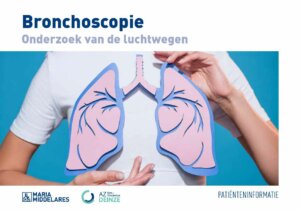Bronchoscopy
What is it?
What is it?A bronchoscopy is a test where the pulmonologist looks at the inside of your airway. This is done using a bronchoscope: a flexible tube with a camera. The physician can see everything directly on a screen. Pieces of lung tissue can be removed with the bronchoscope to subsequently examine them microscopically.
A bronchoscopy provides the physician with additional information about the cause of your symptoms.
The test can be necessary in order to:
- determine whether you have a lung abnormality;
- diagnose a lung condition (e.g. infection or tumour);
- detect and test mucosa abnormalities;
- remove mucosa that is deeper in the lungs or to examine this mucosa in the laboratory;
- detect and remove a foreign object;
- localise and treat bleeding in the lungs;
- perform a selective lung lavage, if needed.
A bronchoscopic examination seems like it would be painful, but it is not. It is not a pleasant test, but with the use of modern-day instruments and with the options for local anaesthesia, it can be performed quickly so that you do not feel too uncomfortable. The physician may decide to perform the procedure under general anaesthesia. In which case, he or she will discuss this with you.
At the Intensive Care Department, we first monitor the vital functions of seriously ill patients or patients who threaten to develop a life-threatening problem. We use several different techniques to monitor these vital functions. One of these techniques is a bronchoscopy. For this technique, a camera is placed in the airway to detect pulmonary conditions as quickly as possible.
Leaflet
LeafletOnly available in Dutch:

Bronchoscopie
DownloadCentres and specialist areas
Centres and specialist areas
Something wrong or unclear on this page? Report it.
Latest publication date: 13/08/2024
Supervising author: Dr Lamont Jan








